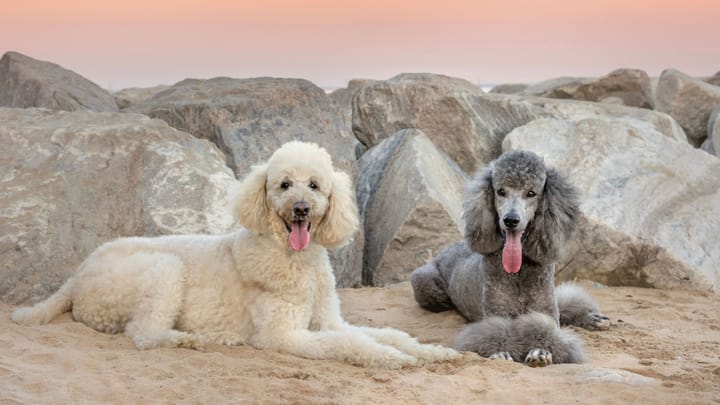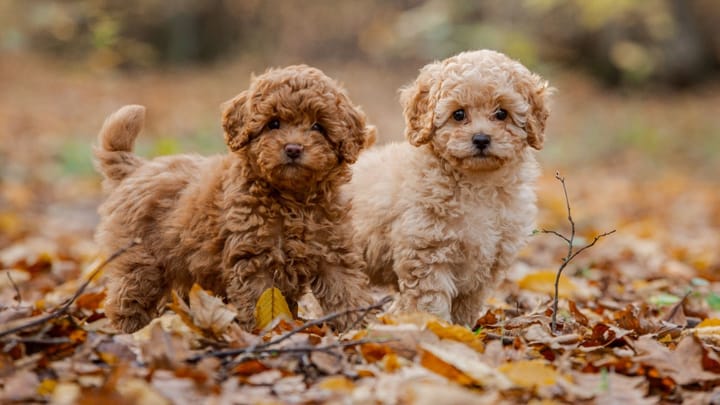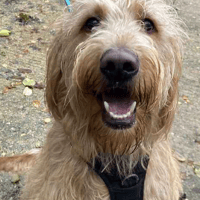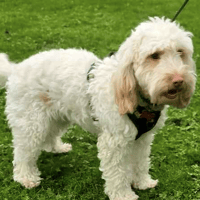Poodle
Other names : Caniche, Pudelhund


The Poodle comes in four sizes (toy, miniature, medium and standard) and five different coat colours (black, white, grey, brown or apricot). They are very intelligent dogs who, despite their misleadingly fragile appearance, are actually very robust and resilient. Cheerful, playful, lovable and affectionate, Poodles can adapt to many different lifestyles.
|
Life expectancy |
The Poodle has a life expectancy of between 12 and 19 years |
|
Temperament |
|
|
Size |
Medium
|
|
Adult size |
Female
Between 9 and 24 in
Male
Between 9 and 24 in
|
|
Adult weight |
Female
Between 13 and 51 lb
Male
Between 13 and 51 lb
|
|
Coat colour
The coat is always a solid colour: black, white, cream, brown, silver, red, though apricot-coloured Poodles are particularly appreciated. Colours derivative of beige are not admissible and grey coats must neither be ‘blackish’ nor ‘whitish’. |
Black White Brown Sand |
|
Type of coat
The coat is medium-long. The coat is curly but can, in rare cases, be corded. Other than that it is abundant, thin, wooly, quite frizzy and elastic. In the case of corded coats, the rope-like mats must be a minimum of 8 inches in length. |
Long |
|
Eye colour
The eyes are usually black or dark brown. In individuals sporting a brown coat, the eyes tend to be amber-coloured. |
Brown
|
|
Purchase price |
The Poodle costs between £640 and £875 |
So-called ‘Doodles’ have been around for a few years now. It is one of those emerging breeds that tend to eventually be officially recognised, but is currently still only considered to be a hybrid.
The ‘Doodles’ are crosses between the Poodles and other breeds. For instance, there is the Goldendoodle (Golden Retriever x Poodle), the Labradoodle (Labrador x Poodle) as well as other smaller breeds crossed with the Toy Poodle.
These dogs are becoming increasingly popular, especially in the United States and in Australia, because of their remarkable set of qualities derived from the crossing of so-called working and service dogs with more malleable and, more importantly, hypoallergenic breeds such as the Poodle.
The initial goal of this type of cross-breeding was to produce service dogs for people with allergies to dog fur. And even if this has given rise to many abuses of power on the part of greedy, opportunist breeders, the idea of the crossbreed itself is by all means worthy.
More details about the Poodle
Poodle: Origins and history
This currently predominantly companion dog’s ancestor was a fierce, rather primitive hunter of feral character: the Barbet, a water hunting dog. The Poodle was in fact originally employed in the hunting of water birds. Contemporary breeding has since focused on the production of companion dogs, resulting in one of the most beloved and widespread breeds in the world. Despite all of this, the dog’s name still references a hunting capacity in almost all languages: in french, ‘Caniche’ comes from the word ‘cane’, which is the female designation for a duck. It is called ‘Pudel’ in german and Poodle in english, both of which mean ‘swimmer’.
Physical characteristics of the Poodle
The four size-based varieties (standard, medium, miniature and toy) are subdivided into five further categories: black, white, grey, brown and apricot. The same general standards do however apply to all varieties. This dog’s general constitution is harmoniously and proportionately-built, covered in the breed’s signature curly coat; a corded variety exists, but it has become very rare. The head has an elegant appearance- elongated, well-defined, and proportional to the frame: it should neither be heavy or imposing nor too dainty. The rather solid neck supports a head proudly held high. The body is of even proportions, with the frame only slightly longer than its height. The limbs are perfectly straight. The chest’s circumference, measured just behind the shoulders, must be at least 4 inches greater than the shoulder height. The tail, set high, is shortened to around a third of its natural length. It hangs aslant. The dog’s demeanour is one of the breed’s important characteristics: light on her feet and rather ‘prancy’ in her step, the poodle’s posture resembles that of an Arabian horse.
FCI classification of the Poodle
-
Group 9 - Companion and Toy Dogs
-
Section 2 : Poodle
Poodle: Varieties
- Miniature Poodle
- Standard Poodle
- Medium Poodle
- Toy Poodle
- Miniature Poodle
- Medium Poodle
- Standard Poodle
Poodle: Characteristics
Poodle: Behaviour
Training a Poodle
This dog is very easy and pleasant to train, since she rapidly integrates what is asked of her. Endowed with an exceptional intelligence and sensitivity, coercive training methods will only serve to impact her in a very negative way. You must therefore prioritise gentle methods based on positive reinforcement and trust.
Despite her great docility, the training process must be implemented as soon as the Poodle pup integrates the house, so as to prevent her from developing any bad habits- especially in the case of toy and miniature specimens, which one tends to be more lenient towards.
Poodle: Lifestyle
Breed compatibility Poodle
Poodle: Purchase price
The price of a Poodle varies depending on its origins, and variety (toy, miniature, medium or standard). You have to count an average of £875 for dogs registered at the Kennel Club.
Depending on her size, the monthly budget required to meet this companion dog’s needs will range from £20 to £40 per month.
Poodle: Shedding
Light
The Poodle belongs to those dogs that experience only very little hair loss, making them a particularly good choice for people allergic to dog saliva and hair.
Poodle: Grooming
Depending on whether the dog takes part in shows or not, her grooming will have to be more or less diligent. For show dogs, a rather precise trimming will have to be carried out by a professional dog groomer (or handler), which entails an investment in terms of time and money, particularly in the case of standard-sized poodles.
Regarding companion dogs that do not take part in shows, regular care is still needed: weekly brushes (or more) are key, and regular grooming/trimming are essential in maintaining the coat’s shapliness.
Poodle: Health
Life expectancy is 15 years on average.
This dog’s only weak point are her ears: they are vulnerable to infections if not cleaned on a regular basis. It is otherwise a very robust dog, and by far the longest-living dog around: she lives not a dozen, but 15 years on average, and many times even longer!
During the summer, and especially during heatwaves, you are advised to reschedule your walks to early in the mornings, and late in the evening, and to opt for walks along water sources which the dog could take a quick dip in to freshen up. Of course, fresh water at will and a spot in the shade must be made at her disposal.
The toy and miniature varieties are slightly more fragile and do often suffer in the cold. They must therefore reside indoors.
It is especially during training sessions that one tends to spoil one’s pooch with several reward snacks- and that is a good thing! But if this is the case, be sure to regulate this in regards to daily meals, to avoid overfeeding this dog, which could rapidly become overweight.
- Ear infections
- Addison’s disease or Hypocortisolism (endocrinological disorder)
- Tracheal collapse (respiratory disease)
- Hip dysplasia








